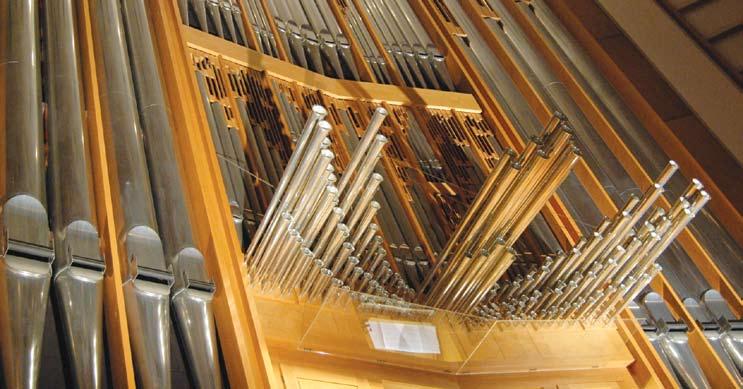布克斯特胡德 (1637-1707) C大調前奏及夏康舞曲,BuxWV 137
F大調聖咏,《來吧,聖靈,尊貴的主》,BuxWV 199
D小調帕薩卡利亞舞曲,BuxWV 161
A小調聖咏,《噢,主,我是可憐的罪人》,BuxWV 178
C大調賦格曲,BuxWV 174
G大調聖咏,《晨星美麗地閃耀》,BuxWV 223
D大調前奏曲,BuxWV 139
G大調聖咏《我的靈魂,現在讚美主》,BuxWV 214, 215, 213, 第2及3節
庫普蘭 (1668-1733)
— 中場休息 —
巴赫 (1685-1750)
舉揚及奉獻經,選自G大調第二彌撒曲
G大調幻想曲,BWV 572
降E大調聖咏,《裝扮吧,我的靈魂》,BWV 654
G大調聖咏,《巴比倫河畔》,BWV 653
G小調賦格曲,BWV 578
C小調帕薩卡利亞舞曲及賦格曲,BWV 582
Dietrich Buxtehude (1637-1707) Prelude and Chaconne in C, BuxWV 137
Komm Heiligen Geist, Herr Gott in F, BuxWV 199
Passacaglia in D minor, BuxWV 161
Ach Herr, mich armen Sünder in A minor, BuxWV 178
Fugue in C, BuxWV 174
Wie schön leuchtet der Morgenstern in G, BuxWV 223
Praeludium in D, BuxWV 139
Nun lob mein Seele den Herren in G, BuxWV 214, 215, 213, verses 2 and 3
François Couperin (1668-1733) From the II Mass: Elévation et Offertorium in G
— Interval —
Johann Sebastian Bach Fantasie in G, BWV 572 (1685-1750)
Schmücke dich, o liebe Seele in E flat, BWV 654
An Wasserflüssen Babylon in G, BWV 653
Fugue in G minor, BWV 578
Passacaglia and Fugue in C minor, BWV 582
Ton Koopman
湯.庫普曼1944年於荷蘭茲沃勒 出生,在阿姆斯特丹完成古典教育 後,繼續研習管風琴、古鍵琴及音樂 學;25歲時成立個人首個巴羅克樂 團,1979年成立阿姆斯特丹巴羅克樂 團,再於1992年成立阿姆斯特丹巴羅 克合唱團。
庫普曼遍演歐洲最著名管風琴;又經 常於阿姆斯特丹音樂廳、巴黎香榭麗 舍劇院、慕尼黑音樂廳、法蘭克福老 歌劇院、紐約林肯中心及卡內基音樂 廳等著名場所,演奏古鍵琴及指揮阿 姆斯特丹巴羅克樂團及合唱團演出。
1994至2004年間,庫普曼致力進行一 項獨一無二的工作:指揮及錄製巴赫 的清唱劇,這項規模龐大的計劃,為 他贏取德國迴聲古典音樂大獎、2008 英國廣播公司大獎以及貝遼士大獎。
庫普曼最近展開了另一項重大工作: 灌錄布克斯特胡德所有作品,他是年 輕巴赫的啟蒙者之一。錄音工作將於 2010年完成,屆時並將推出30張唱 片。庫普曼現為國際布克斯特胡德協 會主席。
庫普曼經常與歐美及日本知名樂團合 作,擔任客席指揮,曾出任荷蘭電台 室樂團首席指揮,合作過的樂團包括 阿姆斯特丹皇家音樂廳樂團、柏林德 意志交響樂團、蘇黎世音樂廳管弦樂 團、巴伐利亞廣播交響樂團及波士頓 交響樂團等。
庫普曼現於海牙皇家音樂學院主持古 鍵琴班,同時是萊頓大學教授,英國 倫敦皇家音樂學院榮譽會員,以及法 國巴羅克藝術節的藝術總監。
Ton Koopman was born in Zwolle in 1944. After a classical education he studied organ, harpsichord and musicology in Amsterdam. At the age of 25, he created his first Baroque orchestra. In 1979 he founded the Amsterdam Baroque Orchestra followed by the Amsterdam Baroque Choir in 1992.
As an organist he has performed on the most prestigious historical instruments of Europe, and as a harpsichord player and conductor of the Amsterdam Baroque Orchestra and Choir he has been a regular guest at venues including the Concertgebouw in Amsterdam, the Théatre des Champs-Elysées in Paris, the Philharmonie in Munich, the Alte Oper in Frankfurt, and the Lincoln Center and Carnegie Hall in New York.
Between 1994 and 2004 Koopman was engaged in a unique project: conducting and recording all the existing Cantatas by Johann Sebastian Bach, a massive undertaking for which he has been awarded the Deutsche Schallplattenpreis Echo Klassik, the BBC Award 2008 and the Prix Hector Berlioz.
Recently Koopman has embarked on another main project: the recording of the whole works by Dietrich Buxtehude, a composer who greatly inspired the young Bach. The recording will be accomplished in 2010 with the release of 30 CDs. Koopman is President of the International Dieterich Buxtehude Society.
Koopman is very active as a guest conductor and has collaborated with many prominent orchestras in Europe, the US and Japan. He has been Principal Conductor of the Netherland Radio Chamber Orchestra and has collaborated with many prestigious orchestras including the Royal Concertgebouw Amsterdam, the Deutsches Symphonie-Orchester Berlin, the Tonhalle Orchestra Zurich, the Orchester des Bayerischen Rundfunks, Munich and the Boston Symphony.
Koopman leads the class of harpsichord at the Royal Conservatory in The Hague, is Professor at the University of Leiden and is an Honorary Member of the Royal Academy of Music in London. He is also artistic director of the French Festival “Itinéraire Baroque”.
©
Jaap
van de Klomp
十七到十八世紀法國作曲家擅長管風琴彌撒曲。此類作品由兩類樂章組成,短小的樂章代替 部份在天主教儀式中頌唱的素歌;較長的樂章則是在彌撒中,當會眾須要靜看祭壇上的儀式 時作配樂之用。這兩首從庫普蘭第二彌撒曲節錄出來的樂章即屬較長的一種。「舉揚經」是沉 思的樂章,為彌撒中最莊嚴的時刻而寫,當中一個喜慶的旋律,在溫柔的和聲背景上,由左 手在另一個鍵盤奏出;「奉獻經」
則是多節樂章,湧現着音色、力度、節奏和拍子的對比。
François Couperin
From the II Mass: Elévation et Offertorium in G
Organ masses were a specialty of 17th- and 18th-century French composers. Consisting of short movements that were substituted for portions of the plainchant that was sung as part of the Catholic liturgy, these masses also include a few longer movements that were played at those times during the service when the congregation was silently observing the celebrant at the altar. The two movements excerpted from François Couperin’s second organ mass for this programme are of the latter type. The Elévation, composed for the most solemn moment of the mass, is a contemplative movement in which a rapturous melody, played by the left hand on a separate keyboard, is heard against a gentle harmonic background. The Offertorium, on the other hand, is a multi-sectional movement in which contrasts of colour, dynamics, rhythm and meter come to the fore.
巴赫
G大調幻想曲,BWV 572
降E大調聖咏,《裝扮吧,我的靈魂》,BWV 654
G大調聖咏,《巴比倫河畔》,BWV 653
G小調賦格曲,BWV 578
C小調帕薩卡利亞舞曲及賦格曲,BWV 582
在十八世紀,巴赫是公認最了不起的管風琴家,他的創作自然成為管風琴的基本曲目;這個 晚上演奏的兩首大型聖咏前奏曲,都取自一份被稱為「十八聖咏曲集」的巴赫手稿。巴赫繼 承布克斯特胡德的傳統,在兩首作品中的聖咏曲調上都加了裝飾音。G大調幻想曲 是這一節 的第一首,由三部份組成,中段節奏較慢,和聲豐富,而前後兩部份則以絢麗的經過樂段為 焦點;對比之下,G小調賦格曲
有嚴格的對位組織,接連的主題述句,結合以主題相關的動 機為本的插段,廣闊的主題得以發展。為音樂會壓軸的,是較早期的作品C小調帕薩卡利亞 舞曲及賦格曲,展示了巴赫在擴展舊有體裁上那出人意表的功力。樂曲由一個八小節的低音 線述句開始,支持在其上開展的20個變奏;低音線模仿的發展段,與一個新的對題樂句,總 結了這首巴赫最宏偉的賦格曲。
樂曲介紹:麥嘉倫 中譯:黃家慧
Johann Sebastian Bach
Fantasie in G, BWV 572
Schmücke dich, o liebe Seele in E flat, BWV 654
An Wasserflüssen Babylon in G, BWV 653
Fugue in G minor, BWV 578
Passacaglia and Fugue in C minor, BWV 582
In the 18th century, Johann Sebastian Bach was widely recognized as the most accomplished organ player of his day, and not surprisingly, his compositions for the instrument have become staples of the organ repertoire. This evening’s performance includes two large-scale chorale preludes from a manuscript collection referred to as the “Great 18 chorales”. For both of them, Bach used ornamented versions of the chorale tunes, building on the same tradition as Buxtehude. The Fantasie in G, which opens the programme, is a three-part work in which a slow and harmonically rich centre is flanked by outer sections that are marked by florid passagework. Unlike the Fantasie, the Fugue in G minor is characterized by strict contrapuntal organisation in which an expansive subject is developed across a sequence of thematic statements and episodes built upon motives related to the subject. The concert concludes with the Passacaglia and Fugue in C minor, a relative early work, but one which demonstrates Bach’s uncanny ability to expand and enlarge upon existing genres. It opens with the statement of an eight-measure bass line that forms the underlying support for an additional twenty variations that unfold above it. The work ends with the imitative development of the bass line, alongside a new countersubject, in one of Bach’s grandest fugues.
Programme notes by Michael McClellan





